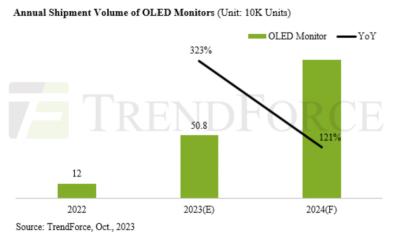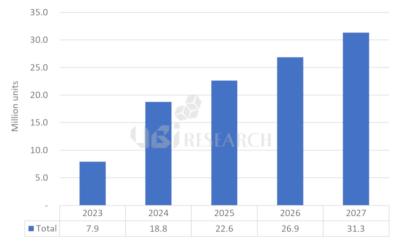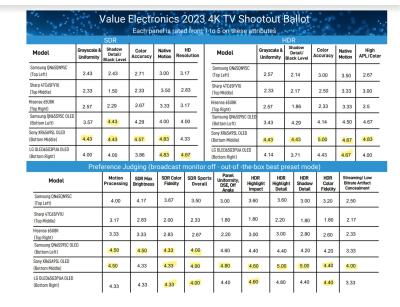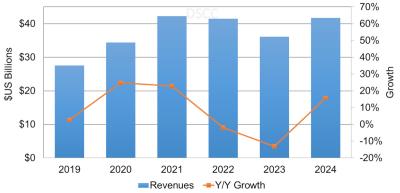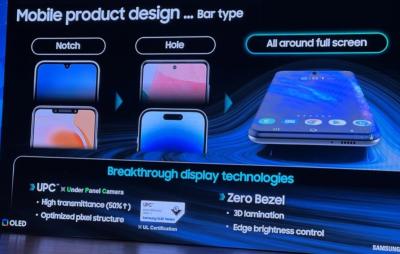OLED is an emerging display technology that is fast becoming the mainstream display technology in many markets, as OLED enables display panels that offer the best image quality and free design as they can be made flexible and transparent. The Samsung OLED displays are considered to be the best in the industry and the Korean company is the clear lead in AMOLED production for mobile devices.

Over the pay years Samsung invested billions of dollars in OLED research and production facilities as the company sees OLEDs fast replacing LCD displays in all mobile applications.
Samsung AMOLED displays
Samsung is currently producing over 300 million AMOLED displays in a year, used mostly in smartphones - such as Samsung's own Galaxy S7 (and S7 edge ) - but also in smartphones from Gionee, Meizu, Acer, HP, Vivo, Microsoft, Lenovo, ZTE, Hisense, Konka and others. Samsung also produces large mobile OLEDs for tablets, laptops and monitors.
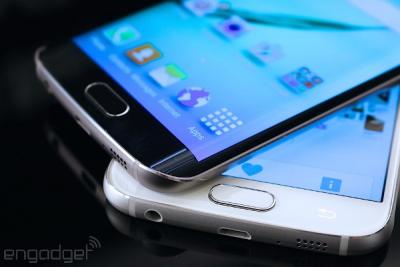
In August 2013 Samsung launched the company's first OLED TV, the KN55S9C, which used a curved 55" OLED panel. The TV was priced at around $8999 in the US and Korea, but is no longer in production, and was never in real mass production. In 2022, Samsung returned to OLED TV production, and is now offering QD-OLED panels and its first such TV is the S95B.
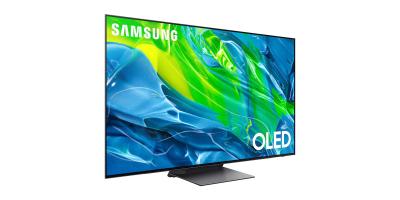
Samsung flexible OLED displays
Following its initial flexible OLED production launch in 2013, and the huge success of its edge-type phones, Samsung is currently producing around 9 million flexible OLEDs each month to satisfy demand for the Galaxy S7 edge and its other flexible OLED products. Samsung has reportedly been chosen to supply 100 million flexible OLED panels to Apple's future iPhones.

Future Samsung OLED devices
Samsung is developing several next generation display technologies based on OLEDs. Samsung has been developing a foldable OLED device for a long time - which may dramatically change the mobile device market as it could enable smartphone to turn into tablets or phones that can be folded into smaller devices.
Samsung is also developing transparent OLEDs (see the company's 55" FHD transparent and mirror-type OLEDs here) for retail application, and also readies next generation displays for the automotive industry.
Several years ago Samsung released the following video, showing a concept transparent flexible AMOLED tablet device. It will be years before Samsung can commercialize such a display, but it's nice to see what the future holds:
Further reading
The latest Samsung OLED news:
Samsung to bring AMOLED displays to its lowest-cost phone lineup
According to reports from Korea, Samsung Electronics has decided to adopt an AMOLED displays in its upcoming budget phone, the Galaxy A15. This will be the lowest cost Samsung phone to ever sport an OLED display.
Most of Samsung's entry-level phones use an LCD, but it seems that as prices of OLED panels continue to drop, Samsung is introducing its OLED into a wider range of phones. In fact it is said that Samsung's production cost of a rigid OLED is currently lower than the production cost of an equivalent LCD display. The A15 will use a 6.4" rigid (glass-based) panel, and the phone itself will cost around $270 when it launches next year, for the 5G variant.
The Elec: Samsung Display is interested in maskless OLED production processes, looking for an exclusive license
A report from Korea's The Elec publication says that Samsung Display is highly interested in next-generation OLED deposition technologies, that are not based on a metal mask (FMM). Several companies are developing and commercialization such technologies. As these may enable higher-performance OLED production, Samsung Display is interested.
A few months ago we reported that SDC is interested in SEL's maskless production technology, and indeed the new The Elec report states that the two companies are in talks. SEL is one of the three companies we are aware of that have advanced maskless technologies, the other two being Visionox and Japan Display. Samsung Display is mostly interested in a technology that it can exclusively license as it does not want other companies to produce OLEDs using the same technology. Both Visionox and JDI are interested in using their technologies in-house, which is a problem for SDC.
TrendForce: over a million OLED monitors to ship in 2024
TrendForce says that 508,000 OLED monitors will ship in 2023, up 323% from 2022. The market will continue to grow at a fast pace, to over a million shipments in 2024.
In 2024, TrendForce sees LG and Samsung both launching new OLED panels for the monitor market, which will help to expand the market. TrendForce further says that at the end of 2023, Samsung Electronics and LGE both hold a market share of almost 30%, Dell holds a market share of around 20% and Asus of nearly 10%.
A senior researcher formerly working at Samsung Display, accused of stealing OLED trade secrets with an aim to sell them to Chinese display makers, returns to Korea to face chargers
In 2021, we reported that two researchers working at Samsung Display were convicted of handing over OLED technology to other companies, and are being sent to prison for two years. Representative and directors of the company that bought the technology was also sent to prison and the company was fined. The technology in question relates to Optical Adhesive Materials used in OLED production processes. The arrest of these employees was reported earlier in 2020.
It is now reported that another employee of Samsung Display, also involved in that case (seems to be he was the main organizer of the outfit) fled Korea following his indictment, but has now returned voluntarily to Korea and has been arrested and is now bring charged with violating unfair competition laws in Korea.
UBI: The OLED IT panel market will grow at a CAGR of 41% to reach 31 million units by 2027
UBI Research estimates that 7.9 million AMOLED displays for IT applications (tablets, notebooks and monitors) will ship in 2023, growing to 31 million by 2027 (a CAGR of 41%). Apple's adoption of OLED screens starting in 2024 will fuel much of the demand.
OLED makers, led by Samsung, LG, BOE and Visionox are all expected to start producing IT OLED panels in existing 6-Gen production lines, and companies are also planning to construct new dedicated 8.5-Gen lines for IT applications.
QD-OLED TVs win the 2023 4K Value Electronics TV display shootout
Value Electronics hosted their annual TV shootout, checking several high-end TVs to see which model provides the best images. The TVs were professionally calibrated, and tested one next to the other. In total, Value Electronics' shootout featured 6 65" 4K TVs - 3 OLEDs and 3 MiniLED LCD. IN the 8K shootout, there were 3 TVs, from Samsung, Sony and LG. As in previous years, OLED TVs were crowned the "King of TVs", in both the 4K and 8K categories.
For the 4K TV shootout, the best TV in the shootout was Sony's A95L QD-OLED TV. The runner-ups were Samsung's S95C (another QD-OLED TV) and LG's G3 OLED (with an LGD WOLED Panel). The 8K shootout's winner was LG's Z2 WOLED TV.
DSCC: the OLED market will decline 13% in 2023, growth to resume in 2024
DSCC estimates that OLED revenues in 2023 will be $36.1 billion - down 13% from last year. Just a few months ago DSCC's forecast for 2023 was $38.9 billion. This is the second year that the OLED market is contracting. In terms of shipments, there will be a 5% decrease in 2023. Looking forward to 2024, DSCC sees the market starting to recover, as demand for IT displays, TVs and smartphones will increase.
Looking at specific markets in 2023, DSCC says that OLED smartphone shipments will remain flat, but will drop 11% in revenues - as the demand for higher-end flexible displays is lower than in 2022. The only positive is the foldable display market, where shipments will increase 33% in 2023 compared to last year. 2023 also experiences a big drop in demand for OLED TVs - DSCC sees shipments declining 31% in 2023. The same goes for laptop OLEDs - a 32% decrease in sales in 2023.
Apple cancels BOE's iPhone 15 panel orders, orders more displays from Samsung
In March 2023 we reported that BOE is developing smartphone OLED displays for Apple's iPhone 15 range, but it is facing technical hurdles, and Apple has yet to approve BOE's displays (the main problem seemed to be around the punch-hole and selfie camera and FaceID sensors).

Today Korean media says that Apple decided to cancel all of BOE's iPhone 15 display panel orders, and has moved all these orders to Samsung Display. Meanwhile LG Display has been approved as a supplier to only some of the iPhone models (specifically not the iPhone 15 Pro Max phone), and Samsung Display remains the only company that provides the displays for all of the iPhone 15 models.
Apple may use an MLA AMOLED display in future iPhone devices
According to reports from Korea, both Samsung Display and LG Display have approached Apple, offering to produce MLA (Multi-Lens Array) AMOLED displays for a future iPhone device. Applying the MLA panel will increase the light output, but will carry higher costs and may also reduce the viewing angles (or actually reduce the side-view brightness).

It is not clear what kind of effect will MLA offer in Apple's case. When LG applied MLA to its TV panels, the company says it improved the brightness by 60% (it also stated that viewing angles actually increased by 30%). Apple will not be the first one to apple MLA to smartphone displays - Samsung itself adopted MLA panels in some of its high-end models (Galaxy S Ultra phones) and so did some other vendors.
Samsung advances towards its under-display-camera solution and a bezel-less OLED display
During a trade show, Samsung Display discussed its zero-border, or full-screen OLED technology. Samsung is developing several technologies to enable this kind of display - including 3D bonding, edge brightness control, and an under-the-display camera (Samsung calls its UPC, under-panel-camera).
Placing the camera under the OLED is a critical part of this solution, and Samsung said that it is developing the technology to enable this - including an increase of 50% in the light transmission of its OLED displays and a new sub-pixel structure that improves the display quality.
Pagination
- Previous page
- Page 6
- Next page


